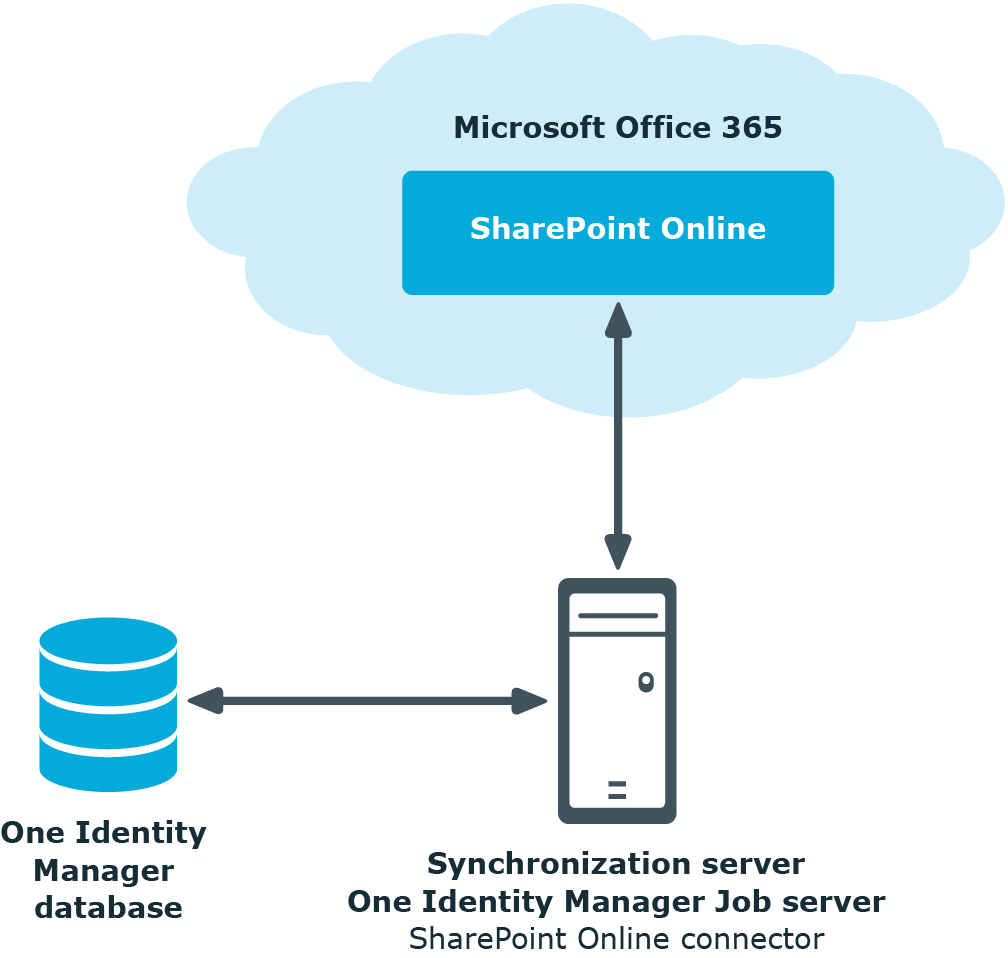Mapping a SharePoint Online environment in One Identity Manager
One Identity Manager offers simplified user administration for SharePoint Online environments. One Identity Manager concentrates on the mapping of site collections, sites, and groups that exist within a cloud environment.
One Identity Manager provides company employees with the user accounts required to allow you to use different mechanisms for connecting employees to their user accounts. You can also manage user accounts independently of employees and therefore set up administrator user accounts.
The system information for the SharePoint Online structure is loaded into the One Identity Manager database during data synchronization. It is only possible to customize certain system information in One Identity Manager due to the complex dependencies and far reaching effects of changes.
For more information about the SharePoint Online structure, see the SharePoint Online documentation from Microsoft.
Related topics
Architecture overview
To access SharePoint Online tenant data, the SharePoint Online connector is installed on a synchronization server. The synchronization server ensures data is compared between the One Identity Manager database and SharePoint Online. The SharePoint Online connector is part of the SharePoint Online Module and responsible for communicating with the SharePoint Online part of Microsoft Office 365 subscriptions in the cloud. The Microsoft CSOM (Client-side object model) is used for accessing the SharePoint Online data.
NOTE: For access to the data of a SharePoint Online tenant, the Azure Active Directory tenant to which the SharePoint Online tenant is connected must be synchronized.
For more information about synchronizing an Azure Active Directory tenant, see the One Identity Manager Administration Guide for Connecting to Azure Active Directory.
Figure 1: Architecture for synchronization

One Identity Manager users for managing SharePoint Online
The following users are used for setting up and administration of SharePoint Online.
Table 1: Users
|
Target system administrators |
Target system administrators must be assigned to the Target systems | Administrators application role.
Users with this application role:
-
Administer application roles for individual target system types.
-
Specify the target system manager.
-
Set up other application roles for target system managers if required.
-
Specify which application roles for target system managers are mutually exclusive.
-
Authorize other employees to be target system administrators.
-
Do not assume any administrative tasks within the target system. |
|
Target system managers |
Target system managers must be assigned to the Target systems | SharePoint Online application role or a child application role.
Users with this application role:
-
Assume administrative tasks for the target system.
-
Create, change, or delete target system objects.
-
Edit password policies for the target system.
-
Prepare groups to add to the IT Shop.
-
Can add employees who have another identity than the Primary identity.
-
Configure synchronization in the Synchronization Editor and define the mapping for comparing target systems and One Identity Manager.
-
Edit the synchronization's target system types and outstanding objects.
-
Authorize other employees within their area of responsibility as target system managers and create child application roles if required. |
|
One Identity Manager administrators |
administrator and administrative system users Administrative system users are not added to application roles.
administrators:
-
Create customized permissions groups for application roles for role-based login to administration tools in the Designer as required.
-
Create system users and permissions groups for non role-based login to administration tools in the Designer as required.
-
Enable or disable additional configuration parameters in the Designer as required.
-
Create custom processes in the Designer as required.
-
Create and configure schedules as required.
-
Create and configure password policies as required. |
|
Administrators for the IT Shop |
Administrators must be assigned to the Request & Fulfillment | IT Shop | Administrators application role.
Users with this application role:
|
|
Product owners for the IT Shop |
Product owners must be assigned to the Request & Fulfillment | IT Shop | Product owners application role or a child application role.
Users with this application role:
|
|
Administrators for organizations |
Administrators must be assigned to the Identity Management | Organizations | Administrators application role.
Users with this application role:
|
|
Business roles administrators |
Administrators must be assigned to the Identity Management | Business roles | Administrators application role.
Users with this application role:
|
Configuration parameters
Use configuration parameters to configure the behavior of the system's basic settings. One Identity Manager provides default settings for different configuration parameters. Check the configuration parameters and modify them as necessary to suit your requirements.
Configuration parameters are defined in the One Identity Manager modules. Each One Identity Manager module can also install configuration parameters. In the Designer, you can find an overview of all configuration parameters in the Base data > General > Configuration parameters category.
For more information, see Configuration parameters for managing SharePoint Online.

